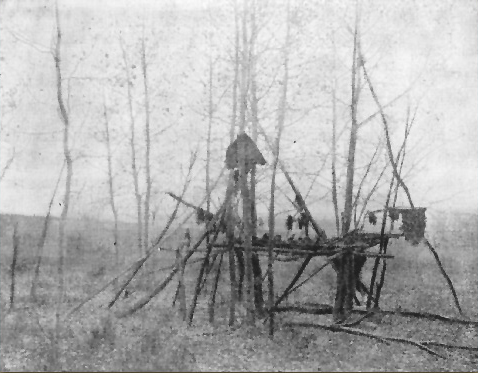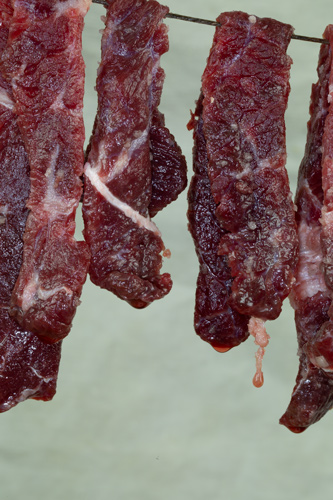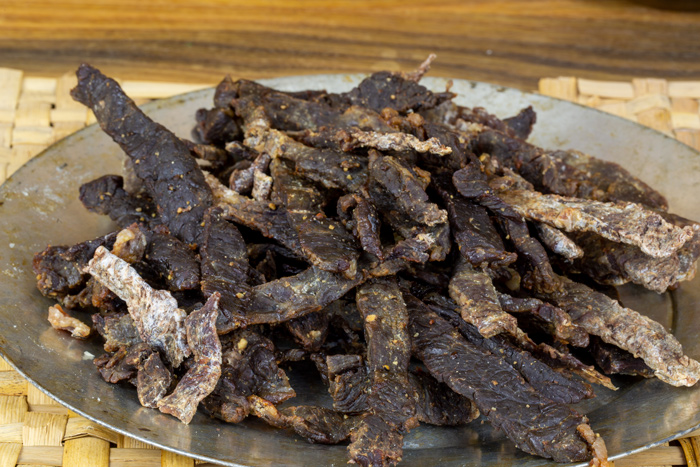Jerked Bison
© 2020 by Kristopher K. Townsend. Permission to use granted under the Creative Commons Attribution-Share Alike 4.0 International license.
Indian Process of Drying “Jerked” Meat on Scaffolds
Photographer unknown for Olin D. Wheeler, The Trail of Lewis and Clark. See also Wheeler’s “Trail of Lewis and Clark”.
Salted Jerky
© 2020 by Kristopher K. Townsend. Permission to use granted under the Creative Commons Attribution-Share Alike 4.0 International license.
Above, the jerked meat’s juices drip after the addition of salt.
Finished Jerky
© 2020 by Kristopher K. Townsend. Permission to use granted under the Creative Commons Attribution-Share Alike 4.0 International license.
Above: Jerky made from two pounds of buffalo steak, salt, and pepper; and dried in an oven following the recipe on this page.
In mid-July of 1805, when the explorers were anticipating a lack of game in the mountains they were soon to enter, Meriwether Lewis remarked in his journal, “we eat an emensity of meat; it requires 4 deer, an Elk and a deer, or one buffaloe, to supply us plentifully 24 hours.” At Fort Mandan in early November of 1804, on a fifteen-day hunt that took them thirty miles downriver from Fort Mandan, six hunters (whose names were never mentioned) killed and processed a total of 34 deer, 10 elk and 5 buffalo, according to Whitehouse, “all weighing 2,000 lbs as near as we could guess.” (One suspects that figure represented the total amount of meat they brought back from all 49 animals.) Seemingly extravagant success such as this by no means represented killing for its own sake, but the accumulation of a food supply that would tide them over the days when the hunters shot few if any animals. In the long run they frequently went hungry despite all their efforts to be prepared. Lewis cited one of those efforts during the days when Clark was surveying a portage route around the Great Falls of the Missouri. On 20 June 1805 he sent out four hunters to kill some buffalo.
My object is if possible while we have now but little to do, to lay in a large stock of dryed meat at this end of the portage to subsist the party while engaged in the transportation of our baggage &c, to the end, that they may not be taken from this duty when once commenced in order to surch for the necessary subsistence.
Whenever they found themselves with more fresh meat than they would eat in a day or two, they “jurked” (or “jirked”) it. “Jerky” is a phonetic transliteration of the Spanish word charqui and the Bolivian and Chilean word charquear, a verb meaning to pound or “beat up, knock the stuffing out of.” In general, at the time of the expedition “jerk” simply stood for “dried meat.” The Peruvian idiomatic expression estar hecho un charqui means “to be shriveled up.”[1]The Oxford Spanish Dictionary (2003), s.v. “charqui.” They “fleesed” the meat, that is, sliced it thin—probably from 1/8 to ¼—and with the grain so as to be able to dry it quickly in the sun and wind, or over fires.[2]Noah Webster, in his Compendious Dictionary (1806), did not use any form of the word “fleece” or “flease” as used in the expedition’s journals. It appears to have been a … Continue reading At best it was nothing like the deliciously smoked or spiced commercial jerky that is made today, but was a tough, often ill-flavored emergency food—a substitute for better fare. As Lewis complained one day at Fort Clatsop, “Some marrow bones and a little fresh meat would be exceptable; I have been living for two days past on poor dryed Elk, or jurk as the hunters term it.”
Jerking Meat
On 24 June 1804 the party stopped at midday to jerk the deer meat they had recently killed. They may have hung it on the rigging of the boats, or else improvised some sort of scaffolding, for they were under way again within a couple of hours. The next few days were clear, probably warm, and windy.
During the winter of 1806 at Fort Clatsop, the mild, moist climate confounded most of their efforts to keep the meat of the elk and deer they shot from spoiling, which seriously diminished the health and energy of every man.
After departing from Fort Clatsop in the spring of 1806, the Corps faced the urgency of securing and preserving enough meat to feed themselves between The Dalles and Nez Perce country on the west side of the Bitterroot Mountains. Lewis considered making pemmican, but persistent rain interfered with the drying processes. On the morning of 5 April the captains sent Sergeant Ordway and a few other men to assist Sergeant Pryor in bringing in the meat of four elk that Drewyer and the Field brothers had shot on the third, and which Sergeant Pryor and three men had been sent to dry on scaffolds over fires.
At 1 P. M [on the 5th] the party returned with the meat. . . . it had been so illy dryed that we feared it would not keep. . . . we therefore directed it to be cut thinner and redryed over a fire this evening. The deerskins which we have had cased for the purpose of containing our dryed meat are not themselves sufficiently dryed for that purpose, we directed them to be dryed by the fire also. . . . the weather has been so damp that there was no possibility of pounding the meat as I wished.
The next morning they secured the dried meat in the prepared skins, loaded the canoes, and continued up the Columbia River.
One of the more notable successes along this line was achieved by Drouillard, Shannon, and Reubin Field in the game park up the Medicine River beginning on 19 July 1805. They returned to camp on the twenty-fifth with “about 800 lbs of excellent dryed meat and about 100 lbs of tallow.”
Salt and Pepper
As today’s modern jerky recipes attest, salt and pepper are favorite additions to the meat before drying. The expedition cooks often had salt at their disposal, but not always. On 28 September 1805, at the Clearwater Canoe Camp, Gass reported that “Salt also is scarce without which fish is but poor and insipid.” The following Christmas at Fort Clatsop, 25 December 1805, he reported, “We have no kind of provisions but meat, and we are without salt to season that.” Despite an infusion of salt made at the salt works that winter, salt would remain a scarce resource until returning to the caches made at the Falls of the Missouri. For more, see on this site, Salt-curing Meat.
The journalists infer that pepper was rationed to the enlisted men only for special occasions. On Christmas Eve at Fort Mandan, 24 December 1804, Whitehouse writes, “in the evening our Captains contributed to the party Some flour pepper dryed apples &c. to celebrate the Chrisstmas.” The officer’s mess, however, may have included pepper more frequently. Lewis’ includes pepper in his dissertation on Toussaint Toussaint Charbonneau‘s recipe for boudin blanc on 9 May 1805. A month later, after a brief illness during his exploration of the Falls of the Missouri, Lewis indulges in a fine meal that includes salt and pepper:
my fare is really sumptuous this evening; buffaloe’s humps, tongues and marrowbones, fine trout parched meal pepper and salt, and a good appetite; the last is not considered the least of the luxuries
—Meriwether Lewis, 13 June 1805
Lewis again includes pepper as a part of a ‘recovery meal’ when making a soup for the ailing Sacagawea at lower portage camp:
The Indian woman much better today, I have still continued the same course of medecine; she is free from pain clear of fever, her pulse regular, and eats as heartily as I am willing to permit her of broiled buffaloe well seasoned with pepper and salt and rich soope of the same meat; I think therefore that there is every rational hope of her recovery.
—Meriwether Lewis, 17 June 1805
Recipe
Before cooking, appreciate the difference between ingredients available to the expedition and what is available to the modern cook. Their choices depended on supplies on hand, the hunters’ skill and luck, their location, and the time of year. Their meat options were primarily buffalo, venison, elk, and bear. If none of those options are available, today’s “jerk” can use beef. Salt and pepper are optional. If you desire a more modern recipe, you can add garlic, onion salt, a small bit of cayenne pepper, or even MSG. There are numerous other jerky recipes online.
- 2 pounds buffalo, venison, elk, or beef roast or steak cut
- Seasonings to taste:
- Salt
- Pepper
- Put the meat in the freezer for about 20 minutes or until firm.
- Slice meat into 1/8 to 1/4-inch thick strips.
- Trim off any fat.
- If you choose to add seasoning, place the meat and the seasonings in a bag, seal, and shake until well-coated.
- Dry the meat using the method that works best for you:
Sun: Hang the strips on a drying rack or strings in a location with hot sun and wind.
Oven: Lay strips on wire baking racks and heat at 250° for 2½ to 3 hours with door slightly ajar.
Grill: Roast over medium-low coals for 2½ to 3 hours.
The finished jerky should be slightly chewy, and the edges should splinter when bent.
A Word to the Wise
Jerking meat does not fully preserve it. A frequent complaint during the expedition was meat turning bad, even when dried. This author has even had jerky turn moldy while stored in the freezer. Food historian Mary Gunderson further warns: “Food safety guidelines advise that meats cooked at temperatures lower than 300° F are subject to bacterial growth during cooking. Use you own discretion when making jerky.”[3]Mary Gunderson provides recipes for jerky and pemmican in The Food Journal of Lewis & Clark: Recipes for an Expedition (Yankton, South Dakota: 2003), 68–69, 81. See also 212. Most often, their jerky was fried in grease or boiled in water before eating which would help kill bacteria.
To further preserve jerked meat, plains Indians had perfected the technique of using jerky to make pemmican. The expedition cooks made pemmican on at least two occasions. For more including a recipe, see on this site Making Pemmican.
Notes
| ↑1 | The Oxford Spanish Dictionary (2003), s.v. “charqui.” |
|---|---|
| ↑2 | Noah Webster, in his Compendious Dictionary (1806), did not use any form of the word “fleece” or “flease” as used in the expedition’s journals. It appears to have been a nonce word with two spellings and two meanings. 1) As a verb: In December of 1805 Clark used it in lieu of “to slice”: “We fleece all the meat and hang it up over a Small Smoke.” Sgt. Ordway (18 February 1805) used “flease” in the same sense: “we fleased the meat from the bones and eat the marrow out of them.” 2) As a noun: On 1 August 1804 Clark celebrated his birthday by ordering from his chef (York?) “a Saddle of fat Vennison, an Elk fleece & a Bevertail to be cooked.” Here “fleece” was a slice of elk meat, possibly a flank steak. In mid-May of 1805 Lewis recorded that the hunters had killed an old grizzly bear whose flesh was so “indifferent” that they “only took the skin and fleece, the latter made us several gallons of oil.” Here, “fleece” possibly referred to a layer of fat under the skin (Moulton, Journals, 4:155 n). On Christmas Day, 1805, Clark “recved a presnt of Capt L. of a fleece hosrie,” undoubtedly wool stockings. Years later, artist George Catlin, in his North American Indian Portfolio (1844), II, liv. 181, used it in to denote “The fleece (hump) of a fat cow.” In 1891 the noun appeared in the Army & Navy Journal (N.Y., 5 Sept., 30-31) in a somewhat more specific sense: “The fleece [of a buffalo] is the meat lying on each side of the hump ribs and resting on the outside of the side ribs” (Oxford English Dictionary). |
| ↑3 | Mary Gunderson provides recipes for jerky and pemmican in The Food Journal of Lewis & Clark: Recipes for an Expedition (Yankton, South Dakota: 2003), 68–69, 81. See also 212. |
Experience the Lewis and Clark Trail
The Lewis and Clark Trail Experience—our sister site at lewisandclark.travel—connects the world to people and places on the Lewis and Clark Trail.
Discover More
- The Lewis and Clark Expedition: Day by Day by Gary E. Moulton (University of Nebraska Press, 2018). The story in prose, 14 May 1804–23 September 1806.
- The Lewis and Clark Journals: An American Epic of Discovery (abridged) by Gary E. Moulton (University of Nebraska Press, 2003). Selected journal excerpts, 14 May 1804–23 September 1806.
- The Lewis and Clark Journals. by Gary E. Moulton (University of Nebraska Press, 1983–2001). The complete story in 13 volumes.





